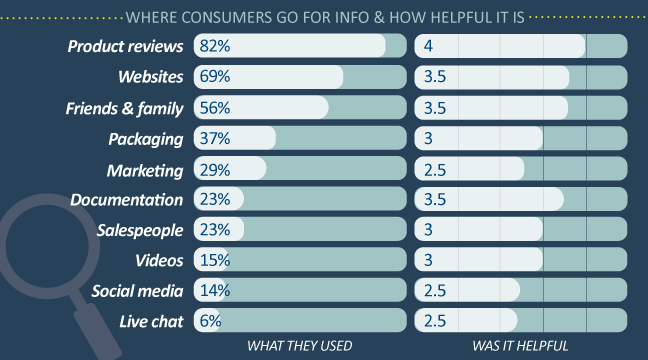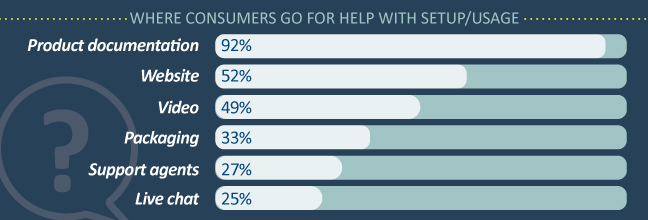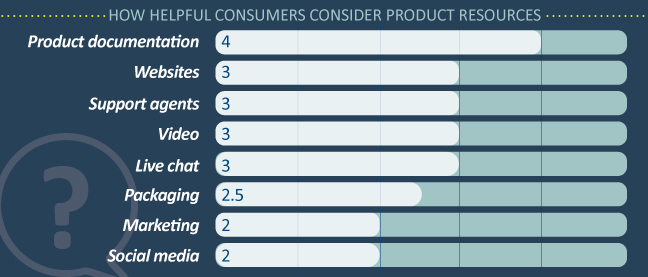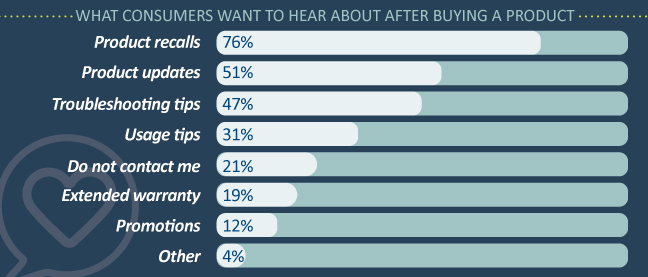In 2018, we ran a national survey of consumers, asking them about needs, wants, and experience with product communications – both before and after purchase. Two years later, as the COVID-19 pandemic raged and online shopping exploded, we saw retailers and service providers struggle to adapt to a digital-first world and to connect with consumers in a meaningful way. We wondered if consumer needs had changed and, more importantly, if those needs were being met. For answers, we relaunched a modified online survey of consumers in October of 2020.
KEY FINDINGS/TAKEAWAYS:
If we had to pick one key theme emerging from this year’s survey, it would be this: If you want to connect with customers effectively, you must consider the entire customer journey. Quality content that continuously meets needs, even as those needs change over time, will drive a positive customer experience.
Both male and female respondents ages 18 and older noted that what they need and want from companies had not changed significantly in two years, despite a pandemic. Findings indicate an ongoing need for information both before and after purchase. In particular:
- Consumers view multiple sources when researching a new product. Product reviews, friends/family, and product documentation are considered most helpful. High quality product documentation is viewed as a reliable source of information for consumers considering a new product.
- After purchase, more than 92% use product documentation for setup and usage, and more than 76% prefer setup guides and manuals printed and provided with a product.
- Support is used fairly often throughout the product lifecycle. Documentation, company websites, and support agents are rated as most helpful.
- Many get very frustrated with poor quality tech support or product documentation.
- In general, most prefer less communication from a company after a product purchase. Unwanted communication is not well-received. If consumers want something, they will look for it or request it themselves.
SURVEY HIGHLIGHTS:
Here are survey results and open-ended comments, organized by steps along a customer journey.

AWARENESS & CONSIDERATION: HOW CONSUMERS SHOP
We first asked consumers what they typically use when considering a product purchase. Multiple answers were allowed. Respondents reported that, depending on the product, they may look several places before making a final purchase decision. As one participant noted, “Expensive products mean more research.” This means they might visit more sources and review each in greater detail.
The top five sources reported were reviews (82%), websites (69%), friends/family (56%), packaging (37%), and marketing materials such as flyers and signage (29%). Others included product documentation (23%), salespeople (23%), videos (15%), social media (14%), and live chat (6%).
Consumers were then asked to rate those sources on helpfulness. Findings indicate that many appear to deliver as consumers might expect. For example, most said they look at product reviews when they are researching a new product. Product reviews were rated as most helpful (4.29). It might be inferred that people go to certain sources because they expect those sources to provide useful information. The fact that product reviews were both #1 on the sources list and top-rated in helpfulness indicates that, in general, respondents got what they expected from product reviews. On the opposite end of the spectrum, 15% or less said they watch videos, check company social media, or go to live chat. All three were rated 2.95 or less on helpfulness, indicating the possibility that least-used sources are used infrequently because they’re expected to be least helpful.
With some exceptions. For example, nearly 69% of respondents said they visit websites when researching new products but rated them less helpful than friends/family or product documentation, indicating potential disappointment. At the same time, only 23% said they look at product documentation, but rated it third most helpful, indicating that product documentation could be an asset during the consideration phase of the customer journey.

Scale: 1 = not helpful at all, 2 = a little helpful, 3 = somewhat helpful, 4 = very helpful, 5 = extremely helpful
CUSTOMER SUPPORT: A CRY FOR HELP
Some products come ready to use as-is. Others require assembly, setup, or just more complex to use. We asked consumers what they typically use when they need help with setup or usage. The vast majority (92%) said they review product documentation. That’s not their only resource, however. Slightly more than half said they visit the company website, while 33% said they look at packaging and 47% reported watching videos. Slightly less than 30% turn to support agents or live chat.

We also asked consumers how often they access select types of product information both immediately and well after purchase. Respondents reported that they typically use each information source more directly after purchase than afterward. No sources were rated as 1 (never)–indicating that product communication is used fairly often throughout the product lifestyle.

Scale: 1 = never, 2 = occasionally, 3 = somewhat often, 4 = very often, 5 = extremely often
We then asked respondents to rate, on a scale of 1–5, how helpful they consider various resources when accessed for product support. With a rating of 4.03, product documentation was the clear leader. Company websites were next (3.4), followed by support agents (3.33), videos (3.13), live chat (3.05), and product reviews (3.02). Packaging, marketing materials (flyers/signs), and social media trailed behind with ratings of 2.53, 2.02, and 1.99, respectively.

Scale: 1 = not helpful at all, 2 = a little helpful, 3 = somewhat helpful, 4 = very helpful, 5 = extremely helpful
Because product documentation was, by far, the most common source and most helpful for help using a product, we also asked consumers how they typically use it. Nearly 64% said they jump to specific sections, while 33% said they read through everything. None said they never read product documentation when they need help. Nearly 97% said they typically read about setup, followed by features (76%), troubleshooting (71%), and usage (48%). Safety, warranties, accessories, and legal trailed significantly behind with percentages of 29%, 24%, 14%, and 3%, respectively.
Most (76%) said that, if a product has a setup guide and user manual, they want both printed and provided in the box. Nearly 19% said they want the setup guide printed and user guide online. Five percent said they prefer both documents be available online only.
The entire topic of help resources and helpfulness of each appears to have struck a chord, as nowhere else did respondents comment as frequently or with as much emotion as they did in this section. Many responses demonstrate unmistakable levels of frustration.
“I would love access to support via phone, but it is usually too painful to get through or find someone actually helpful. If I’m stuck, I will go to videos.”
“Much prefer to talk to a live person on phone or in chat. HATE automated chat bots and automated phone attendants.”
“User manuals are usually very very poorly written. I wonder sometimes if anyone reads them and tries the instructions. Support offered by companies would be so much more helpful if you could get to a human quickly. I detest robots when I call a company as much as I detest them when I try the chat. I know companies want to save time but wasting my time instead is not a good bargain.”
“Yeah, what support agents would that be? None of you answer phones or emails and most don’t answer their “chat” messages. IF they do, it’s some person in India who knows nothing and can answer nothing.“
“All documents should be written or at least proofed by someone with basic literacy skills; help desks should be staffed with people who speak unaccented English and have successfully completed a course in elocution (proper diction, enunciation, and articulation)”
“User manuals and setup guides need to be written by someone fluent in the language they are writing in, and for the benefit of the customer… write it in plain English instead of Legalese.”
“I would not be pleased if I had to access things online and the paperwork wasn’t provided with the product”
CUSTOMER LOYALTY: STAYING IN TOUCH
Once consumers buy a product, how much do they want to hear from the company they bought the item from? In general, it appears they want less. If they do need something, they prefer to access it on their own terms. As one respondent noted, “[I] do not like being automatically added to email lists.” Respondents noted that, if they want anything at all, it is limited to specific information. Product recalls topped the list at 76%, with product updates and troubleshooting tips coming in around 50%. Everything else was lower.

If consumers need information, such as product updates or usage tips, most (67%) reported they go for product documentation, with troubleshooting and product reviews close behind, at 63% and 62%, respectively. Thirty-seven percent reported looking for features, videos, and FAQs.
Most also said they don’t follow companies on social media. Forty-two percent of those might said they would do so to get information about new products and services or to get promotions/discounts.
We also asked consumers how they prefer to return or replace a product, if necessary. Nearly 72% said they prefer to return to a store. Eighteen percent said they call a support agent, while 10% do a live chat.
While most respondents prefer limited communication from a company after product purchase, some shared ideas for what they might like: “It would be great if in the future you want an accessory you could go to the website and plug in your exact model and get all the accessories that would work with it (and be assured they would work with it.)” In the end, it appears consumers are open to ongoing communication but only if they perceive value in it.
IN SUMMARY
What can marketers learn from survey results? A lot, it turns out.
Expand your horizons. While great marketing content may start the engagement, it’s important to consider the entire customer journey and what consumers need along each step of the way. A customer’s experience with a brand or product is driven by content that continuously meets their needs, even as those needs change over time. A communications strategy provides the framework in which to achieve that.
Think about all the various touchpoints customers might need throughout a product’s lifecycle. Don’t rely on a single channel or dismiss the value of another because you don’t think it’s important or necessary. Numerous factors, such as demographics and product complexity, may impact where consumers go for product information so relying on one channel only is short-sighted. Offering content across many channels gives consumers options and ensures access to the information they need to make an informed purchase decision. Content that complements each other reinforces messaging to help ensure consumers understand information correctly.
Daniel Murray, Chief Empathy Officer with Empathic Consulting, suggests, “Let’s really dive into understanding the customer: not from our world, from our perspective, but from the customer’s perspective. Let’s sit in that place with them, or imagine how it is in their world, and discuss what their needs are, what they love, what they fear, what’s important to them. Then, we can step back to our frameworks and think, ‘How can we best serve these needs with the toolsets we have?’”
Best Buy CEO Corie Barry reiterated the point in her CES 2021 keynote by stating, “We need to agnostically meet that customer wherever they are.”
Execute with care. Content that misses or glosses over useful information could do more harm than good. Avoid consumer disappointment, frustration, or anger by thoughtfully crafting every customer communication piece, starting with your website. This is especially critical in a digital-first world where a customer’s journey might start with a website. According to an article by Jamie FitzHenry for The Realtime Report, “Your website is a major representation of your company and brand. The experience a visitor has on your site will reflect the feelings they have about your business.”
The experience a consumer has with packaging, documentation, and other collateral does as well. Utilize professional content developers—writers, editors, and graphic designers—to craft messaging and visuals that reflect your brand and resonate with customers. Outsource, if you need help with this. Employ behavioral science expertise to help make sure online materials are user-friendly and easy to navigate. If information is vague or confusing, consumers may become frustrated or worse, abandon the search entirely and go to another brand. Think about things like language, accessibility, and usability and leverage customer data whenever possible.
Employees can affect customer experience too. Thoroughly train sales staff, tech support and customer service personnel. Consumers reported an overwhelming desire to communicate with someone who is knowledgeable about the product, understands an issue, is able to clearly articulate with customers, and actually cares whether or not customers get the help they need.
Provide the level of information appropriate within each channel so that, regardless of where consumers look when they’re considering a product, information is complete, accurate, and understandable. The quality of content provided can help build a loyal customer base that has a higher value than acquiring new customers.
Leverage data. Effective customer communications start with good data. Data helps companies better understand customer wants and needs, likes and dislikes. Data helps companies determine if what they’re doing works. Look at review comments and ratings to identify potential issues. See what drives tech support and customer service calls. Look at online search terms to help guide SEO. Check out document downloads to see which pages are visited the most. Ask customers for direct feedback. Don’t assume you know your customer without supporting data.
Gina Balarin, author, TEDx and keynote speaker, and Founder of Verballistics, asserts, “Creating empathetic content requires marketers to shift their focus—from educated assumptions about transactional needs to a deeper, more holistic understanding of their audience.” Daniel Murray adds, “The biggest barrier to empathy is assuming we already understand.”
Data helps a company better understand a customer’s entire journey with a product–up to and beyond the point of sale. Offering clear, concise, compelling, and easy-to-understand information—online, on the phone, in store, or in person—is a critical step towards creating a positive customer experience that ultimately strengthens brand image and creates loyal brand advocates. Rachel Tuffney with MarketingProfs, advises, “Identifying the right content is the first major step, followed by the context in which it is delivered.” Data helps inform both.
Want to learn more about this survey and how it might help you grow your business? Contact us for information on how we can help.
RESOURCES:
https://therealtimereport.com/2020/01/23/5-stats-that-prove-the-importance-of-web-design/
https://informa.turtl.co/story/chief-content-officer-2021-preview/page/6?elq_mid=957&elq_cid=228188











